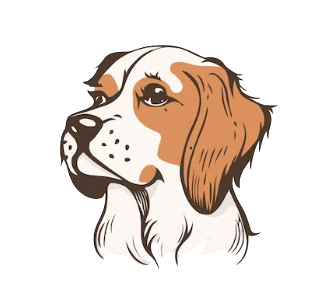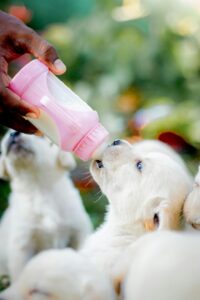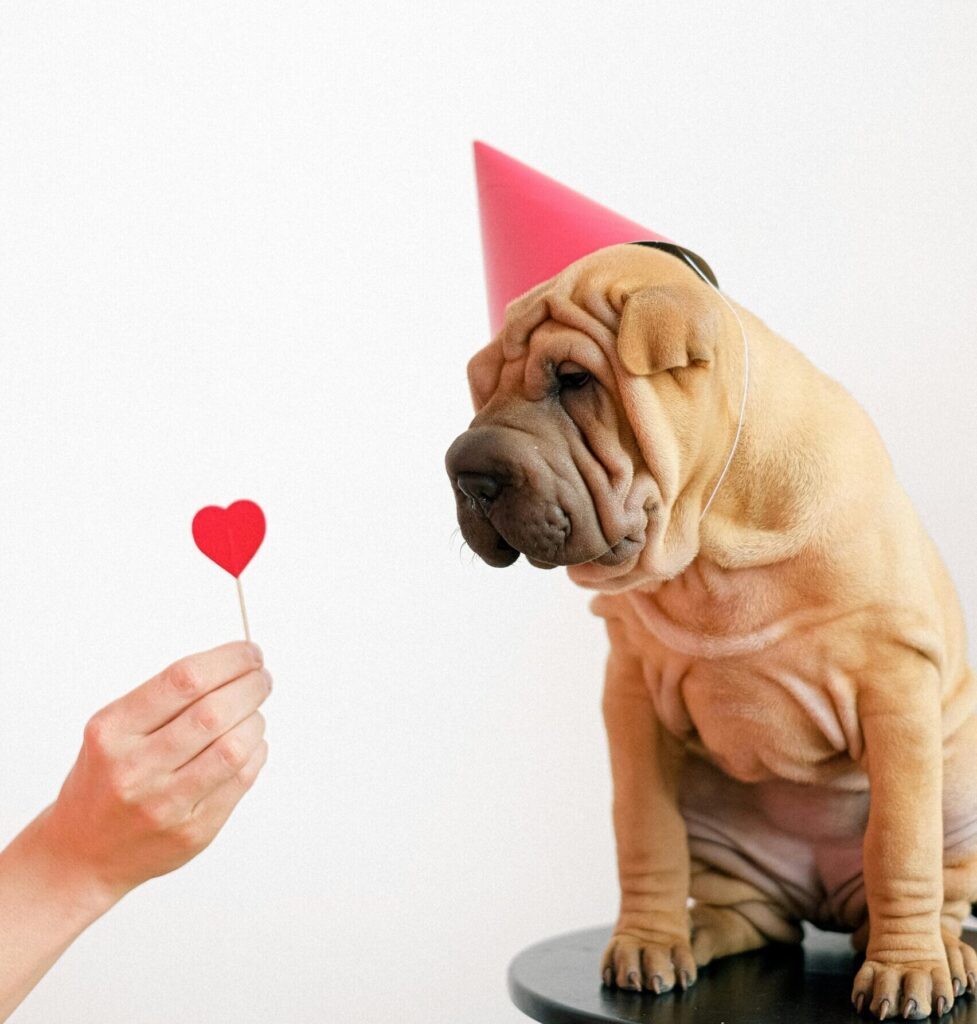A puppy has arrived at home? How exciting! Remember that one of the most important things for your furry friend to grow up healthy and strong is proper nutrition. But how much should a puppy eat? Here are our tips on the right doses for puppies and young dogs.
Summary
- How much should a puppy eat: the size
- Providing adequate rations to your puppy
- Pay attention to the growth curve
- How much should a puppy eat: wet and dry
- How Much Should a Puppy Eat: BARF Diet
- Divide the portions
- The reward during training!
1- How much should a puppy eat: the size
To understand how much a puppy should eat, you must first understand that not all dogs are the same and that each breed grows at its own pace. In principle, we can consider that the smaller the size, the faster your furry friend will reach its final size. Large and giant breed dogs need more time: the growth phase, in these puppies, lasts longer. The table below gives you a general idea of the growth times of each breed:
[blockquote align=”none” author=”Unknown”]”A well-fed puppy is a happy puppy, ready to explore the world with boundless energy.”[/blockquote]
|
Adult dog body weight |
End of the growth phase |
|
Small dogs (up to 10 kg) |
8 to 10 months |
|
Medium sized dogs (11 to 25 kg) |
12 months |
|
Large dogs (26 to 44 kg) |
15 to 18 months |
|
Giant breed dogs |
18 to 24 months
|
As you can see, compared to their small friends, large dogs need many more months to grow: this is why, if your four-legged friend is a large dog, it is important to follow a diet for puppies and young dogs until about two years of age.
Small furry pets, such as theMaltese , can switch to adult dog food already from the first year of age. The larger sizes, however, will enjoy puppy food for longer … of course remember to fill your furry friend’s bowl more and more, as he grows!
To learn more, read our article on puppy diet .
2- Providing adequate rations to your puppy
Puppies are often big eaters. So why not indulge your new furry friend by feeding him everything he wants? Simple: too much energy will make him grow faster, with the risk of developing musculoskeletal diseases that he will have to live with for the rest of his life. This is why it is important to understand right away how much a puppy should eat.
Excess calories are particularly dangerous in large and giant breed dogs, such asGreat Danes , which can be considered adult dogs starting from practically 18 months.
 3- Pay attention to the growth curve
3- Pay attention to the growth curve
Knowing the growth chart is a great way to keep track of your puppy’s body weight until he or she grows up: you can easily compare the average weight of furry friends like yours from the age of 8 weeks to 18 months.
Breeders of larger breeds will often provide a growth chart if you choose to go to one of them, otherwise you can find one by asking a veterinarian who specializes in nutrition, or simply by searching online for the specific growth chart for your new four-legged friend’s breed.
This is an objective assessment tool, and therefore much more reliable than monitoring your puppy’s health “by eye”. Don’t rely on what you see! Many humans tend to fill their furry friend’s bowl when they see him particularly thin… ignoring the fact that in all likelihood the puppy is so lanky because he has just had a growth spurt! Feeding him more will not make him gain weight, on the contrary, the puppy will continue to grow more and more rapidly.
To have a reference value for the growth of large dogs, we can consider that at the age of 6 months these puppies should weigh a little more than half (about 60%) of what their final weight will be.
4- How much should a puppy eat: wet and dry
With some examples we show you how to adjust the recommended daily rations both to the individual growth phases of your puppy and on the basis of its final size. Attention, the examples are valid only for the food product reported from time to time: in fact, the indications vary based on the nutritional values of each individual food.
Wet food table: Lukullus Junior
As an example for wet foods, we have chosen the productsLukullus Junior . This product is also available in 800 gram cans and is therefore also convenient for large dogs.
Lukullus recommends the following rations for puppies and junior dogs:
|
Final weight |
up to 3 months |
4-6 months |
7-8 months |
|
up to 5 kg |
200g – 400g |
400 g |
400 g |
|
5 – 15 kg |
400g – 800g |
400g – 1,000g |
400g – 800g |
|
16 – 30 kg |
800g – 1200g |
800g – 1.600g |
800g – 1200g |
As you can see, the recommended portions vary over a very wide range, but the nutritional indications for puppies are still a good guideline for determining the daily doses of your furry friend.
Dry Food Chart: Concept for Life X-Large Puppy
If you are instead looking fordry food for your puppy or junior you can enjoy an even wider selection. In fact, there are many dry foods on the market for large breed puppies, but also for small and medium breed dogs.
The smaller your furry friend’s final size, the sooner you can switch to adult dog food. For dogs ofsmall and On average, food is not divided between puppies and juniors: at the age of one year, in fact, these furry friends are already considered adults.
Larger breed dogs, on the other hand, need to switch to foods for young dogs, or junior dogs, before finally feeding on products for adult dogs.READ MORE ON PUPPIES
For example, for dogs considered “Extra-large”, the Concept for Life brand divides its products between puppies and juniors. Below is the table relating to the recommended rations ofConcept for Life X-Large Puppy for dogs up to 8 months.
|
Months of age |
Final weight 45 kg |
Final weight 50 kg |
Final weight 60 kg |
Final weight 70 kg |
Final weight 80 kg |
Final weight 90 kg |
Final weight 100 kg |
|
2 |
310 g |
365 g |
400 g |
420 g |
450 g |
490 g |
530 g |
|
3 |
410 g |
455g |
510 g |
555 g |
605 g |
665 g |
715 g |
|
4 |
455g |
495 g |
560 g |
620 g |
675 g |
735 g |
795 g |
|
5 |
540 g |
585 g |
665 g |
740 g |
815 g |
890 g |
960 g |
|
6 |
615 g |
665 g |
755 g |
840 g |
925 g |
1010 g |
1095 g |
|
7 |
615 g |
665 g |
765 g |
855 g |
945 g |
1030 g |
1115 g |
|
8 |
610 g |
665 g |
765 g |
855 g |
945 g |
1035 g |
1120 g |
From the eighth or ninth month of life, giant breed dogs should switch toConcept for Life Junior :
|
Months of age |
Final weight 45 kg |
Final weight 50 kg |
Final weight 60 kg |
Final weight 70 kg |
Final weight 80 kg |
Final weight 90 kg |
Final weight 100 kg |
|
8 |
605 g |
655 g |
755 g |
850 g |
940 g |
1025 g |
1110 g |
|
9 |
565 g |
615 g |
710 g |
845 g |
935 g |
1025 g |
1110 g |
|
10 |
530 g |
580 g |
665 g |
795 g |
900 g |
980g |
1065 g |
|
11 |
485 g |
540 g |
620 g |
745 g |
850 g |
930 g |
1005 g |
|
12 |
440 g |
505g |
580 g |
695 g |
805 g |
880 g |
955 g |
|
13 |
435 g |
475 g |
545 g |
650 g |
760 g |
830 g |
895 g |
|
14 |
430 g |
470 g |
545 g |
650 g |
760 g |
830 g |
895 g |
|
16 |
Giant Adult |
470 g |
540 g |
610 g |
675 g |
735 g |
800 g |
|
18 |
Giant Adult |
Giant Adult |
535 g |
605 g |
670 g |
735 g |
795 g |
|
20 |
Giant Adult |
Giant Adult |
Giant Adult |
605 g |
670 g |
730 g |
790 g |
|
24 |
Giant Adult |
Giant Adult |
Giant Adult |
Giant Adult |
665 g |
730 g |
790 g |
5- How Much Should a Puppy Eat: BARF Diet
If you want to follow the BARF method to feed your furry friend, we recommend that you get properly informed before starting. While it is true that a puppy eats quantities equal to about four to six percent of its weight every day, it is also absolutely necessary to consider the correct composition of the food in terms of nutrients.
Before starting the BARF diet for your puppy, talk to your veterinarian .
Read our articleBARF for Dogs to find more information about BARF for puppies and junior dogs.
Remember to also include in the daily doses the snacks given as a reward for your furry friend’s successes.
6- Divide the portions
Puppies and young dogs have a naturally smaller stomach than their adult friends. This is why it is important to divide their daily food ration into several portions. If you feed your furry friend several dry foods during the day, using them asreward during thetraining , divide the remaining part of the daily ration into three or four portions at most. After lunch, like all little ones, your puppy also needs to rest for an hour:
a habit that becomes essential in large breeds, to prevent stomach torsion . As soon as your four-legged friend is an adult, it will be sufficient to move on to two portions a day.
7- The reward during training!
For those who choose to train their puppy, exercises often go hand in hand with rewards: especially in large dogs, it is good to remember to also consider these snacks within the daily ration. Your furry friend does not need who knows what delicacies as a reward, his usual kibble will be enough to make him happy!
Weigh the expected ration for a day and put some kibble in yoursnack bag. If you have something left over in the evening, you can add it to your dinner portion.
Is your furry friend a lazy person? You can try to motivate him by adding some inviting-smelling snacks to his kibble, such asWild Bites Wolf of Wilderness. .
Browsing the zooplus Magazine you will find many other tips on howraise your puppy in the best way.
READ MORE ON DOG TRAINING


 3- Pay attention to the growth curve
3- Pay attention to the growth curve



